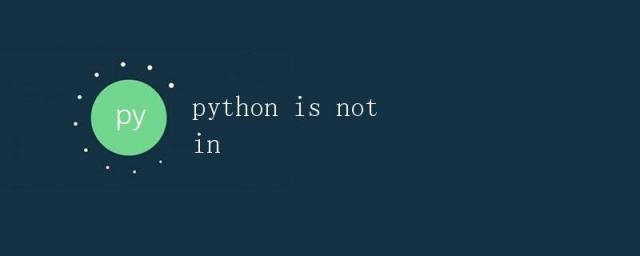Python is not in
2024年05月19日 Python is not in 极客笔记
Python is not in

Python 中的 in 操作符用于检查一个值是否存在于一个序列(如列表、元组或字符串)中。但是有时候我们可能会用错该操作符,导致出现错误。本文将详细讨论在 Python 中使用 in 时可能出现的问题,并提供一些示例代码来帮助理解。
1. 问题描述
在 Python 中,我们经常会使用 in 来判断一个元素是否存在于一个序列中。比如:
# 判断列表中是否包含某个元素
my_list = [1, 2, 3, 4, 5]
if 3 in my_list:
print("3 is in my_list")
else:
print("3 is not in my_list")
上面的代码将输出 3 is in my_list,因为 3 存在于 my_list 中。但是有时候,我们可能会犯一个常见的错误,即误用 in 操作符。下面我们将讨论一些示例。
2. 使用 in 的常见问题
2.1. 判断子字符串是否存在于字符串中
在 Python 中,我们可以使用 in 来判断一个子字符串是否存在于一个字符串中。比如:
my_str = "Hello, world!"
if "world" in my_str:
print("world is in my_str")
else:
print("world is not in my_str")
上面的代码将输出 world is in my_str,因为子字符串 "world" 存在于字符串 my_str 中。但是如果我们误将字符串写在前面,会导致错误:
my_str = "Hello, world!"
if my_str in "world":
print("my_str is in world")
else:
print("my_str is not in world")
上面的代码将输出 my_str is not in world,因为此时相当于判断整个字符串 "Hello, world!" 是否存在于字符串 "world" 中,显然是错误的。
2.2. 判断键是否存在于字典中
在 Python 中,我们也可以使用 in 来判断一个键是否存在于一个字典中。比如:
my_dict = {"a": 1, "b": 2, "c": 3}
if "b" in my_dict:
print("Key 'b' is in my_dict")
else:
print("Key 'b' is not in my_dict")
上面的代码将输出 Key 'b' is in my_dict,因为键 "b" 存在于字典 my_dict 中。但是如果我们误将键写在前面,会导致错误:
my_dict = {"a": 1, "b": 2, "c": 3}
if my_dict in "b":
print("my_dict is in 'b'")
else:
print("my_dict is not in 'b'")
上面的代码将抛出 TypeError: 'in <string>' requires string as left operand, not dict 异常,因为此时相当于判断整个字典 my_dict 是否存在于字符串 "b" 中,显然是错误的。
2.3. 判断元素是否存在于集合中
在 Python 中,我们也可以使用 in 来判断一个元素是否存在于一个集合中。比如:
my_set = {1, 2, 3, 4, 5}
if 3 in my_set:
print("3 is in my_set")
else:
print("3 is not in my_set")
上面的代码将输出 3 is in my_set,因为元素 3 存在于集合 my_set 中。但是如果我们误将元素写在前面,会导致错误:
my_set = {1, 2, 3, 4, 5}
if my_set in 3:
print("my_set is in 3")
else:
print("my_set is not in 3")
上面的代码将抛出 TypeError: argument of type 'int' is not iterable 异常,因为此时相当于判断整个集合 my_set 是否存在于整数 3 中,显然是错误的。
3. 如何避免误用 in
为了避免误用 in 操作符,在使用时应仔细检查操作数的顺序,确保判断的目标在前面,被判断的序列在后面。另外,在判断键是否存在于字典中时,只能判断键而不是值。
4. 结论
本文详细讨论了在 Python 中使用 in 操作符可能出现的问题,包括误判断子字符串、键或元素是否存在。为了避免出错,应该始终注意操作数的顺序,确保判断的目标在前面。
本文链接:http://so.lmcjl.com/news/4904/